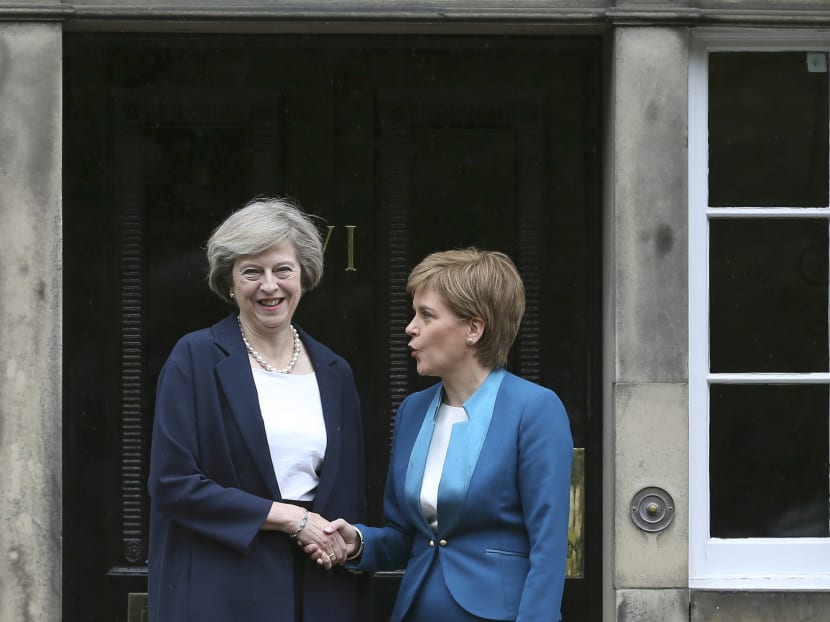‘Glass cliff,’ not just ceiling, often impedes women rising in politics
LONDON — When Mrs Theresa May became the prime minister of Britain in July, she appeared to be confirming a trend rather than establishing one. Northern Ireland is led by a woman. Scotland’s first minister is a woman, and so are the main two Scottish opposition leaders. Even the populist UK Independence Party recently elected its first female leader, though her tenure was short.

UK Prime Minister Theresa May with Scotland's First Minister Nicola Sturgeon at Bute House in Edinburgh, Scotland. Photo: Reuters
LONDON — When Mrs Theresa May became the prime minister of Britain in July, she appeared to be confirming a trend rather than establishing one. Northern Ireland is led by a woman. Scotland’s first minister is a woman, and so are the main two Scottish opposition leaders. Even the populist UK Independence Party recently elected its first female leader, though her tenure was short.
A quarter-century after Margaret Thatcher left power as Britain’s first female leader, it is the centre-left Labour Party that has become the exception, with its recent leadership battle between two men.
The rise of women in British politics is certainly striking — the Green Party is also led by a woman (who shares the job with a man), as is the Welsh nationalist party — but does it amount to progress?
Amid the turmoil following the vote to leave the European Union, there is a sense in some quarters that rather than shattering a glass ceiling, female leaders risk tumbling down a “glass cliff” — a theory that holds that women are often placed in positions of power when the situation is dire, men are uninterested and the likelihood of success is low.
“It’s a case of men going, ‘Wow, it can’t get any worse, quick, let’s put a woman in charge,’” said Ms Sandi Toksvig, a writer, comedian and co-founder of the Women’s Equality Party.
The concept of the glass cliff was coined in 2005 by two professors at Exeter University, in England. The researchers, Prof Michelle Ryan and Prof Alexander Haslam, challenged a report that suggested that when companies in the FTSE 100, Britain’s benchmark stock index, appointed women to their boards, share prices often suffered.
What the duo found was that women were more likely to be appointed in times of crisis — and therefore more likely to fail. Subsequent studies of Fortune 500 companies confirmed the trend.
The idea applies to politics, too. Women are still more likely to be nominated in unwinnable constituencies, Prof Ryan said.
That is one reason, behind the impressive list of female leaders, that equality is still a long way off: More men are in the House of Commons today (456 out of 648) than women in its history (452).
Brexit, as the British departure from the EU is known, is a textbook glass cliff. “All the men who were responsible for the mess stabbed each other soundly in the back” and then ran away, Ms Toksvig said.
Mr David Cameron, who had called the referendum, announced his resignation as prime minister. Mr Boris Johnson, the noisiest Brexiteer in the Conservative Party, withdrew his bid to succeed Cameron. In the end, it came down to a choice between Mrs May and another woman, Andrea Leadsom.
“Brexit is really a lose-lose situation for the prime minister,” Prof Ryan said. Nearly half of voters opposed it, and many supporters have unrealistic expectations. “Whatever she negotiates, no one will be happy.”
That may also explain why Mr Nigel Farage, the leader of the UK Independence Party, quickly stepped down after the vote. Faced with an identity crisis after its core goal was achieved in the referendum, the party elected Ms Diane James as its leader last month. But she stepped down Tuesday (Oct 4) after only 18 days in the job.
In Scotland, Ms Nicola Sturgeon became the leader of the Scottish National Party only after a separate referendum on independence was rejected. Ms Kezia Dugdale was elected to run the Scottish Labour Party after it was nearly wiped out in elections. And Ms Ruth Davidson leads the Scottish Conservatives, which has fewer members of Parliament (one) than there are pandas in the Edinburgh Zoo (two).
Not everyone slips on the glass cliff. Under Ms Sturgeon, the Scottish nationalists have added members and triumphed in elections.
Mrs May once wore a T-shirt that read, “This is what a feminist looks like.” She may face an impossible task in negotiating a good Brexit deal, Ms Toksvig said, “but perhaps she could actually do something for women.” THE NEW YORK TIMES






